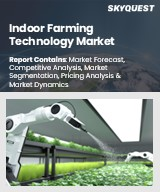
|
시장보고서
상품코드
1609751
일본의 실내 농업 시장 보고서 : 시설 유형, 작물 유형, 구성요소, 재배 시스템, 지역별(2025-2033년)Japan Indoor Farming Market Report by Facility Type, Crop Type, Component, Growing System, and Region 2025-2033 |
||||||
일본의 실내 농업 시장 규모는 2024년 13억 3,670만 달러로 추정됩니다. 향후 IMARC 그룹은 2033년까지 시장 규모가 29억 5,160만 달러에 달하고, 2025년부터 2033년까지 9.2%의 연평균 성장률(CAGR)을 나타낼 것으로 예측했습니다. 비옥한 토지의 제한된 가용성, 전통적인 농업을 어렵게 만드는 가혹한 기상 조건, 환경 건전성을 촉진하는 지속가능성에 대한 관심 증가는 시장을 이끄는 주요 요인 중 일부입니다.
본 보고서에서 다룬 주요 질문
- 일본의 실내 농업 시장은 지금까지 어떻게 발전해 왔으며 앞으로 어떻게 발전할 것인가?
- 코로나19가 일본 실내 농업 시장에 미친 영향은?
- 일본 실내 농업 시장의 시설 유형별 현황은?
- 일본 실내 농업 시장의 작물 유형별 분류는?
- 일본 실내농업 시장의 구성요소별 시장 현황을 알려주세요.
- 일본 실내 농업 시장의 재배 시스템별 현황은?
- 일본 실내 농업 시장의 밸류체인에는 어떤 단계가 있는가?
- 일본 실내 농업 시장의 주요 촉진요인과 과제는?
- 일본 실내 농업 시장의 구조와 주요 업체는?
- 일본 실내 농업 시장의 경쟁은 어느 정도인가?
목차
제1장 서문
제2장 조사 범위와 조사 방법
- 조사 목적
- 이해관계자
- 데이터 소스
- 시장 추정
- 조사 방법
제3장 주요 요약
제4장 일본의 실내 농업 시장 - 서론
- 개요
- 시장 역학
- 업계 동향
- 경쟁 정보
제5장 일본의 실내 농업 시장 구도
- 과거 및 현재 시장 동향(2019-2024년)
- 시장 예측(2025-2033년)
제6장 일본의 실내 농업 시장 - 시설 유형별 분석
- 온실
- 실내 수직 농장
- 컨테이너 펌
- 실내 심수 재배
- 기타
제7장 일본의 실내 농업 시장 - 작물 유형별 분석
- 과일/채소/허브
- 꽃 및 관상식물
- 기타
제8장 일본의 실내 농업 시장 - 컴포넌트별 분석
- 하드웨어
- 소프트웨어
제9장 일본의 실내 농업 시장 - 재배 시스템별 분할
- 에어로포닉스
- 수경재배
- 아쿠아포닉스
- 토양 기반
- 하이브리드
제10장 일본의 실내 농업 시장 - 경쟁 구도
- 개요
- 시장 구조
- 시장 기업 포지셔닝
- 주요 성공 전략
- 경쟁 대시보드
- 기업 평가 상한
제11장 주요 기업 개요
제12장 일본의 실내 농업 시장 - 업계 분석
- 성장 촉진요인 및 억제요인과 기회
- Porter의 Five Forces 분석
- 밸류체인 분석
제13장 부록
LSH 24.12.23The Japan indoor farming market size reached USD 1,336.7 Million in 2024. Looking forward, IMARC Group expects the market to reach USD 2,951.6 Million by 2033, exhibiting a growth rate (CAGR) of 9.2% during 2025-2033. The limited availability of fertile land, harsh weather conditions that make traditional farming challenging, and rising interest in sustainability to promote environmental health represent some of the key factors driving the market.
Indoor farming, also known as controlled environment agriculture, refers to the practice of cultivating plants within an enclosed setting, such as a greenhouse, and a completely closed environment like a warehouse. It relies on vertical farming structures, which enables growers to cultivate plants in stacks and make most of the available space. It allows for the year-round growth of plants, independent of external weather conditions, by controlling factors like light, temperature, humidity, and nutrient levels. It requires significantly less water than traditional soil-based farming as the water in these systems is recirculated. It helps eliminate the need for pesticides as it provides a controlled environment that can be kept free of pests and diseases. It enables the cultivation of fresh produce in urban areas, reduces transportation distances and improves access to fresh food. Moreover, it provides an ideal platform for plant research and allows scientists to control and manipulate the growing environment to better understand plant growth and development.
Japan Indoor Farming Market Trends:
Indoor farming in Japan is currently experiencing growth, largely driven by a combination of societal, technological, and environmental factors. The increasing aging population of the country is gradually leading to a decrease in the workforce involved in traditional farming. This is promoting the adoption of less labor-intensive farming methods, such as indoor farming. Additionally, a large population of Japan is residing on a relatively smaller land area, much of which is mountainous and arable land. As a result, vertical farming, a type of indoor farming, is gaining popularity due to its ability to maximize crop yield per square meter, making efficient use of available space. Moreover, the country is frequently exposed to harsh weather conditions, such as typhoons and heavy rainfall, which devastates outdoor crops. This, in turn, is increasing the need for indoor farming as a more reliable and resilient method of food production. Additionally, advancements in technologies, such as light-emitting diode (LED) lighting, automation, and artificial intelligence are enhancing the efficiency and productivity of indoor farms in Japan. Besides this, innovations in hydroponics, aeroponics, and aquaponics systems are also driving the market in the country.
Key Market Segmentation:
Facility Type Insights:
- Greenhouse
- Indoor Vertical Farms
- Container Farms
- Indoor Deep Water Culture
- Others
Crop Type Insights:
- Fruits, Vegetables, and Herbs
- Lettuce
- Spinach
- Kale
- Tomato
- Herbs
- Bell and Chilli Peppers
- Strawberry
- Cucumber
- Others
- Flowers and Ornamentals
- Annuals
- Perennials
- Ornamentals
- Others
- Others
Component Insights:
- Hardware
- Structure
- LED Lights
- HVAC
- Climate Control Systems
- Irrigation Systems
- Others
- Software
- Web-based
- Cloud-based
Growing System Insights:
- Aeroponics
- Hydroponics
- Aquaponics
- Soil-based
- Hybrid
Competitive Landscape:
- The report has also provided a comprehensive analysis of the competitive landscape in the Japan indoor farming market. Competitive analysis such as market structure, key player positioning, top winning strategies, competitive dashboard, and company evaluation quadrant has been covered in the report. Also, detailed profiles of all major companies have been provided.
Key Questions Answered in This Report:
- How has the Japan indoor farming market performed so far and how will it perform in the coming years?
- What has been the impact of COVID-19 on the Japan indoor farming market?
- What is the breakup of the Japan indoor farming market on the basis of facility type?
- What is the breakup of the Japan indoor farming market on the basis of crop type?
- What is the breakup of the Japan indoor farming market on the basis of component?
- What is the breakup of the Japan indoor farming market on the basis of growing system?
- What are the various stages in the value chain of the Japan indoor farming market?
- What are the key driving factors and challenges in the Japan indoor farming market?
- What is the structure of the Japan indoor farming market and who are the key players?
- What is the degree of competition in the Japan indoor farming market?
Table of Contents
1 Preface
2 Scope and Methodology
- 2.1 Objectives of the Study
- 2.2 Stakeholders
- 2.3 Data Sources
- 2.3.1 Primary Sources
- 2.3.2 Secondary Sources
- 2.4 Market Estimation
- 2.4.1 Bottom-Up Approach
- 2.4.2 Top-Down Approach
- 2.5 Forecasting Methodology
3 Executive Summary
4 Japan Indoor Farming Market - Introduction
- 4.1 Overview
- 4.2 Market Dynamics
- 4.3 Industry Trends
- 4.4 Competitive Intelligence
5 Japan Indoor Farming Market Landscape
- 5.1 Historical and Current Market Trends (2019-2024)
- 5.2 Market Forecast (2025-2033)
6 Japan Indoor Farming Market - Breakup by Facility Type
- 6.1 Greenhouse
- 6.1.1 Overview
- 6.1.2 Historical and Current Market Trends (2019-2024)
- 6.1.3 Market Forecast (2025-2033)
- 6.2 Indoor Vertical Farms
- 6.2.1 Overview
- 6.2.2 Historical and Current Market Trends (2019-2024)
- 6.2.3 Market Forecast (2025-2033)
- 6.3 Container Farms
- 6.3.1 Overview
- 6.3.2 Historical and Current Market Trends (2019-2024)
- 6.3.3 Market Forecast (2025-2033)
- 6.4 Indoor Deep Water Culture
- 6.4.1 Overview
- 6.4.2 Historical and Current Market Trends (2019-2024)
- 6.4.3 Market Forecast (2025-2033)
- 6.5 Others
- 6.5.1 Historical and Current Market Trends (2019-2024)
- 6.5.2 Market Forecast (2025-2033)
7 Japan Indoor Farming Market - Breakup by Crop Type
- 7.1 Fruits, Vegetables, and Herbs
- 7.1.1 Overview
- 7.1.2 Historical and Current Market Trends (2019-2024)
- 7.1.3 Key Segment
- 7.1.3.1 Lettuce
- 7.1.3.2 Spinach
- 7.1.3.3 Kale
- 7.1.3.4 Tomato
- 7.1.3.5 Herbs
- 7.1.3.6 Bell and Chilli Peppers
- 7.1.3.7 Strawberry
- 7.1.3.8 Cucumber
- 7.1.3.9 Others
- 7.1.4 Market Forecast (2025-2033)
- 7.2 Flowers and Ornamentals
- 7.2.1 Overview
- 7.2.2 Historical and Current Market Trends (2019-2024)
- 7.2.3 Key Segment
- 7.2.3.1 Annuals
- 7.2.3.2 Perennials
- 7.2.3.3 Ornamentals
- 7.2.3.4 Others
- 7.2.4 Market Forecast (2025-2033)
- 7.3 Others
- 7.3.1 Historical and Current Market Trends (2019-2024)
- 7.3.2 Market Forecast (2025-2033)
8 Japan Indoor Farming Market - Breakup by Component
- 8.1 Hardware
- 8.1.1 Overview
- 8.1.2 Historical and Current Market Trends (2019-2024)
- 8.1.3 Key Segment
- 8.1.3.1 Structure
- 8.1.3.2 LED Lights
- 8.1.3.3 HVAC
- 8.1.3.4 Climate Control System
- 8.1.3.5 Irrigation Systems
- 8.1.3.6 Others
- 8.1.4 Market Forecast (2025-2033)
- 8.2 Software
- 8.2.1 Overview
- 8.2.2 Historical and Current Market Trends (2019-2024)
- 8.1.3 Key Segment
- 8.1.3.1 Web-based
- 8.1.3.2 Cloud-based
- 8.2.3 Market Forecast (2025-2033)
9 Japan Indoor Farming Market - Breakup by Growing System
- 9.1 Aeroponics
- 9.1.1 Overview
- 9.1.2 Historical and Current Market Trends (2019-2024)
- 9.1.3 Market Forecast (2025-2033)
- 9.2 Hydroponics
- 9.2.1 Overview
- 9.2.2 Historical and Current Market Trends (2019-2024)
- 9.2.3 Market Forecast (2025-2033)
- 9.3 Aquaponics
- 9.3.1 Overview
- 9.3.2 Historical and Current Market Trends (2019-2024)
- 9.3.3 Market Forecast (2025-2033)
- 9.4 Soil-based
- 9.4.1 Overview
- 9.4.2 Historical and Current Market Trends (2019-2024)
- 9.4.3 Market Forecast (2025-2033)
- 9.5 Hybrid
- 9.5.1 Overview
- 9.5.2 Historical and Current Market Trends (2019-2024)
- 9.5.3 Market Forecast (2025-2033)
10 Japan Indoor Farming Market - Competitive Landscape
- 10.1 Overview
- 10.2 Market Structure
- 10.3 Market Player Positioning
- 10.4 Top Winning Strategies
- 10.5 Competitive Dashboard
- 10.6 Company Evaluation Quadrant
11 Profiles of Key Players
- 11.1 Company A
- 11.1.1 Business Overview
- 11.1.2 Product Portfolio
- 11.1.3 Business Strategies
- 11.1.4 SWOT Analysis
- 11.1.5 Major News and Events
- 11.2 Company B
- 11.2.1 Business Overview
- 11.2.2 Product Portfolio
- 11.2.3 Business Strategies
- 11.2.4 SWOT Analysis
- 11.2.5 Major News and Events
- 11.3 Company C
- 11.3.1 Business Overview
- 11.3.2 Product Portfolio
- 11.3.3 Business Strategies
- 11.3.4 SWOT Analysis
- 11.3.5 Major News and Events
- 11.4 Company D
- 11.4.1 Business Overview
- 11.4.2 Product Portfolio
- 11.4.3 Business Strategies
- 11.4.4 SWOT Analysis
- 11.4.5 Major News and Events
- 11.5 Company E
- 11.5.1 Business Overview
- 11.5.2 Product Portfolio
- 11.5.3 Business Strategies
- 11.5.4 SWOT Analysis
- 11.5.5 Major News and Events
12 Japan Indoor Farming Market - Industry Analysis
- 12.1 Drivers, Restraints, and Opportunities
- 12.1.1 Overview
- 12.1.2 Drivers
- 12.1.3 Restraints
- 12.1.4 Opportunities
- 12.2 Porters Five Forces Analysis
- 12.2.1 Overview
- 12.2.2 Bargaining Power of Buyers
- 12.2.3 Bargaining Power of Suppliers
- 12.2.4 Degree of Competition
- 12.2.5 Threat of New Entrants
- 12.2.6 Threat of Substitutes
- 12.3 Value Chain Analysis



















